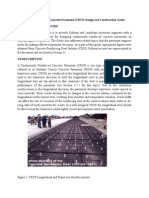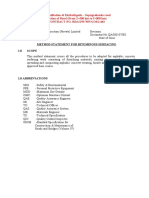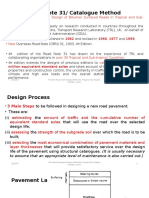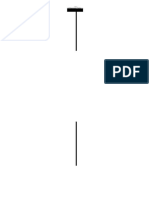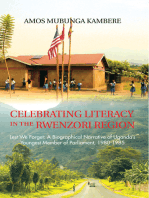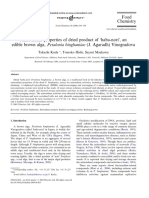11-Gravel Wearing Course Design
11-Gravel Wearing Course Design
Uploaded by
Alexander Luega RelampagosCopyright:
Available Formats
11-Gravel Wearing Course Design
11-Gravel Wearing Course Design
Uploaded by
Alexander Luega RelampagosOriginal Description:
Copyright
Available Formats
Share this document
Did you find this document useful?
Is this content inappropriate?
Copyright:
Available Formats
11-Gravel Wearing Course Design
11-Gravel Wearing Course Design
Uploaded by
Alexander Luega RelampagosCopyright:
Available Formats
Pavement Design Manual Chapter 11
Volume I Flexible Pavements and Gravel Roads - 2002 Gravel and Low Standard Roads
11. DESIGN OF GRAVEL AND LOW STANDARD ROADS
11.1 General
Much of the information presented in this Section of the Pavement Design Manual is
based on the "Pavement and Materials Design Manual" prepared by the United Republic
of Tanzania Ministry of Works 1999, and on relevant ERA and TRL publications.
Available information has been modified to provide a simple procedure to design gravel
wearing courses and low standard roads, which is appropriate to Ethiopian conditions.
Gravel road pavements are generally utilized for roads where design traffic flow Annual
Average Daily Traffic (AADT) is less than 200. This Section sets out the standards for
pavement design, and specifies the materials which may be used for gravel roads.
11.2 Design Principles
11.2.1 STEPS TO BE CONSIDERED IN THE DESIGN PROCESS
1. Traffic (Baseline flow and forecast)
2. Material and geotechnical information (Field survey and material properties)
3. Subgrade (Classification, foundation for expansive soils and material strength)
4. Thickness design (Gravel wearing coarse thickness)
5. Materials design
11.2.2 ALL-WEATHER ACCESS
An essential consideration in the design of gravel roads is to ensure all-weather access.
This requirement places particular emphasis on the need for sufficient bearing capacity of
the pavement structure and provision of drainage and sufficient earthworks in flood or
problem soil areas (e.g. black cotton).
11.2.3 SURFACE PERFORMANCE
The performance of the gravel surface mainly depends on material quality, the location of
the road, and the volume of traffic using the road. Gravel roads passing through
populated areas in particular require materials that do not generate excessive dust in dry
weather. Steep gradients place particular demands on gravel wearing course materials,
which must not become slippery in wet weather or erode easily. Consideration should
therefore be given to the type of gravel wearing course material to be used in particular
locations such as towns or steep sections. Gravel loss rates of about 25-30mm thickness a
year per 100 vehicles per day is expected, depending on rainfall and materials properties
(particularly plasticity).
Performance characteristics that will assist in identifying suitable material are shown in
Figure 11-1.
11.2.4 MAINTENANCE
The material requirements for the gravel wearing course include provision of a gravel
surface that is effectively maintainable. Adherence to the limits on oversize particles in
the material is of particular importance in this regard and will normally necessitate the
use of crushing or screening equipment during material production activities.
Ethiopian Roads Authority Page 11-1
Chapter 11 Pavement Design Manual
Gravel and Low Standard Roads Volume I Flexible Pavements and Gravel Roads 2002
11.3 Design Method
The required gravel thickness shall be determined as follows:
1. Determine the minimum thickness necessary to avoid excessive compressive strain in
the subgrade (D1).
2. Determine the extra thickness needed to compensate for the gravel loss under traffic
during the period between regravelling operations (D2).
3. Determine the total gravel thickness required by adding the above two thicknesses
(D1+ D2).
11.3.1 MINIMUM THICKNESS REQUIRED
It is necessary to limit the compressive strain in the subgrade to prevent excessive
permanent deformation at the surface of the road .Figure 3 gives the minimum gravel
thickness required for each traffic category with the required thickness of improved
subgrade materials for upper and lower subgrade layers.
11.3.2 GRAVEL LOSS
According to TRL Laboratory Report 673, an estimate of the annual gravel loss is given
by the following equation:
GL = f T2 / ( T2 + 50) ( 4.2 + 0.092 T + 3.50 R2 + 1.88V)
Where
GL = the annual gravel loss measured in mm
T = the total traffic volume in the first year in both directions, measured in
thousands of vehicles
R = the average annual rainfall measured in m
V = the total (rise + fall ) as a percentage of the length of the road
f = 0.94 to 1.29 for lateritic gravels
= 1.1 to 1.51 for quartizitic gravels
= 0.7 to 0.96 for volcanic gravels (weathered lava or tuff)
= 1.5 for coral gravels
= 1.38 for sandstone gravels
11.3.3 TOTAL THICKNESS REQUIRED
The wearing course of a new gravel road shall have a thickness D calculated from:
D = D1 + N. GL
Where D1 is the minimum thickness from Figure 11.3
N is the period between regravelling operations in years
GL is the annual gravel loss
Page 11-2 Ethiopian Roads Authority
Pavement Design Manual Chapter 11
Volume I Flexible Pavements and Gravel Roads - 2002 Gravel and Low Standard Roads
Regravelling operations should be programmed to ensure that the actual gravel thickness
never falls below the minimum thickness D1.
11.4 Pavement and Materials
Depending on the CBRdesign of the subgrade, improved subgrade layers shall be
constructed as required, on which the gravel wearing course is placed.
11.5 Crossfall and Drainage
The crossfall of carriageway and shoulders for gravel roads shall be 4% as indicated in
ERAs Geometric Design Manual - 2002. This is to ensure that potholes do not develop
by rapidly removing surface water and to ensure that excessive crossfall does not cause
erosion of the surface. Provision of drainage is extremely important for the performance
of gravel roads.
11.6 Material Requirements
11.6.1 EXPERIENCE WITH LOCAL MATERIALS
Knowledge of past performance of locally occurring materials for gravel roads is
essential. Material standards may be altered to take advantage of available gravel sources
provided they have proved to give satisfactory performance under similar conditions.
11.6.2 MARGINAL MATERIALS
Figure 11-1 illustrates the performance characteristics to be expected of materials that do
not meet the requirements for gravel wearing course. Refinements and amendments of
the standard material specification may be necessary to overcome problem areas such as
towns (dust nuisance) or steep hills (slipperiness).
500 Slippery
Shrinkage Product, SP
400
Good but may be
300 Erodible dusty Ravels
materials Good
200
100
Ravels and corrugates
10 20 30 40
Grading Coefficient, CG
Note: SP = (Linear Shrinkage) x (% passing 0.425 mm)
GC = ((% passing 28 mm) - (% passing 2 mm)x (% passing 5 mm)/100
Figure 11-1. Expected Performance of Gravel Wearing Course Materials
Ethiopian Roads Authority Page 11-3
Chapter 11 Pavement Design Manual
Gravel and Low Standard Roads Volume I Flexible Pavements and Gravel Roads 2002
11.6.3 IMPROVED SUBGRADE LAYER
In General the use of improved subgrade layers has the following advantages:
Provision of extra protection under heavy axle loads;
Protection of underlying earthworks;
Provides running surface for construction traffic;
Assists compaction of upper pavement layers;
Provides homogenous subgrade strength;
Acts as a drainage filter layer;
More economical use of available materials.
11.6.4 SUBGRADE CBR
All subgrade materials shall be brought to a strength of at least a minimum CBR of 7%
for minor gravel roads and at least a minimum CBR 25 % for major gravel roads. The
different types of gravel roads are explained in Section 11.7.
11.6.5 TREATMENT OF EXPANSIVE FORMATIONS
The following treatment operations should be applied on Expansive Formations for
higher class roads of AADTdesign greater than 50:
i) Removal of Expansive Soil
a) Where the finished road level is designed to be less than 2 metres above ground
level, remove the expansive soil to a minimum depth of 600 mm over the full
width of the road, or
b) Where the finished road level is designed to be greater than 2 metres above
ground level, remove the expansive soil to a depth of 600 mm below the ground
level under the unsurfaced area of the road structure, or
c) Where the expansive soil does not exceed 1 meter in depth, remove it to its full
depth.
ii) Stockpile the excavated material on either side of the excavation for subsequent
spreading on the fill slopes so as to produce as flat a slope as possible.
iii) The excavation formed as directed in paragraph (i) should be backfilled with a
plastic non-expansive soil of CBR value 3 - 4 or better, and compacted to a density
of 95% modified AASHTO.
iv) After the excavated material has been replaced with non-expansive material in
150mm lifts to 95% modified AASHTO density, bring the road to finished level in
approved materials, with a side slope of 1:2, and ensure that pavement criteria are
complied with; the previously stockpiled expansive soil excavated as directed under
(i) should then be spread over the slope.
v) Do not construct side drains unless they are absolutely essential to stop ponding;
where side drains are necessary, they should be as shallow as possible and located
as far from the toe of the fill as possible.
vi) Ideally, construction over expansive soil should be done when the in-situ moisture
content is at its highest, i.e. at the end of rainy season.
Page 11-4 Ethiopian Roads Authority
Pavement Design Manual Chapter 11
Volume I Flexible Pavements and Gravel Roads - 2002 Gravel and Low Standard Roads
The following treatment operations may be applied on Expansive Formations for light
traffic class roads of AADTdesign less than 50:
i) Remove 150mm of expansive topsoil and stockpile conveniently for subsequent
use on shoulder slopes
ii) Shape road bed and compact to 90% modified AASHTO
iii) The excavation formed as directed in paragraph (i) should be backfilled with a
plastic non-expansive soil of CBR value 3 - 4 or better, and compacted to a
density of 95% modified AASHTO in each 150mm layer; the subgrade material
may be plastic but non-expansive.
11.6.6 MATERIAL CHARACTERISTICS
Soils used for improved subgrade layers shall be non-expansive, non-dispersive and free
from any deleterious matter. They shall comply with the requirements shown in Table
11-1.
Table 11-1
G7
Material G20
(Lower Layer)
Properties (Upper Layer)
CBR Dry Climatic Zones Minimum 20 after 4 days
Minimum 7 after 4 days soaking
(See Note) soaking
Minimum 20 at OMC
Minimum 7 at OMC
CBR Wet Climatic Zones Minimum 7 after 4 days
Minimum 3 after 4 days soaking
(See Note) soaking
PI [%] Maximum 25 Maximum 30
Compacted Density 95% of AASHTO T180 95% of AASHTO T180
Maximum particle size 2/3 of layer thickness 2/3 of layer thickness
Compacted layer thickness Maximum 200 mm Maximum 250 mm
Note: Climatic Zones for Ethiopia are described in Section 11.10.
11.7 Gravel Wearing Course
11.7.1 PERFORMANCE CHARACTERISTICS OF GRAVEL WEARING COURSE
The materials for gravel wearing course should satisfy the following requirements that
are often somewhat conflicting:
a) They should have sufficient cohesion to prevent ravelling and corrugating (especially
in dry conditions)
b) The amount of fines (particularly plastic fines) should be limited to avoid a slippery
surface under wet conditions.
Ethiopian Roads Authority Page 11-5
Chapter 11 Pavement Design Manual
Gravel and Low Standard Roads Volume I Flexible Pavements and Gravel Roads 2002
Figure 11-1 shows the effect of the Shrinkage Product (SP) and Grading Coefficient
(GC) on the expected performance of gravel wearing course materials. Excessive
oversize material in the gravel wearing course affects the riding quality in service and
makes effective shaping of the surface difficult at the time of maintenance. For this
reason the following two types of gravel wearing course material are recommended.
Type 1 gravel wearing course which is one of the best material alternatives which shall
be used on all roads which have AADTdesign greater than 50. Type 1 material shall also be
used for all routine and periodic maintenance activities for both major and minor gravel
roads. Type 1 or Type 4 gravel wearing course material may be used on new construction
of roads having AADTdesign less than 50. Other alternatives are also specified in this
chapter.
11.7.2 GRAVEL WEARING COURSE MATERIAL SPECIFICATION
Selected material shall consist of hard durable angular particles of fragments of stone or
gravel. The material shall be free from vegetable matter and lumps or balls of clay.
Type 1
The grading of the gravel after placing and compaction shall be a smooth curve within
and approximately parallel to the envelopes detailed in Table 11-2.
The material shall have a percentage of wear of not more than 50 at 500 revolutions, as
determined by AASHTO T96.
The material shall be compacted to a minimum in-situ density of 95% of the maximum
dry density determined in accordance with the requirements of AASHTO T 180.
The plasticity index should be not greater than 15 and not less than 8 for wet climatic
zones and should be not greater than 20 and not less than 10 for dry climatic zones.
The linear Shrinkage should be in a range of 3-10%.
Note that the above gradation and plasticity requirements are only to be used with
angular particles and that crushing and screening are likely to be required in many
instances for this purpose.
Type 2 & 3
These materials may be more rounded particles fulfilling the following:
a) The Plasticity Index lies in a range of 5-12% in wet areas, and in any case less than
16% in other areas
b) The materials have the sanction of local experience
Use of more rounded particles may allow the use of river gravel. Trials should
nevertheless be conducted to verify whether crushing occurs under traffic or whether
crushing should be considered prior to use. Subject to trials, a minimum percentage by
weight of particles with at least one fractured face of 40% may be considered. This
requirement may also be expressed in terms of crushing ratio.
Page 11-6 Ethiopian Roads Authority
Pavement Design Manual Chapter 11
Volume I Flexible Pavements and Gravel Roads - 2002 Gravel and Low Standard Roads
Except for very low traffic (less than 15 vehicles per day), the CBR should be in excess
of 20 after 4 days of soaking at 95% of maximum dry density under Heavy Compaction.
For very low traffic, the requirement may be relaxed to a CBR of 15.
Type 4
This material gradation allows for larger size material and corresponds to the gradation of
a base course material. The use of this gradation of materials is subject to the local
experience and shall be used with PIs in a range of 10-20.
Type 5 & 6
These materials gradations are recommended for smaller size particles. They may be
used if sanctioned by experience with plasticity characteristics as for material Type 1.
Table 11-2
Test Sieve Percent(%) by mass of total aggregate passing test sieve
Size(mm)
Type 1 Type 2 Type 3 Type 4 Type 5 Type 6
50 - - - 100 - -
37.5 100 - 100 80-100 - -
28 - 100 95 - 100 - - -
20 80 - 100 95 - 100 85-100 60-80 100 -
14 - 80-100 65 - 100 - - -
10 55 - 100 65 - 100 55 - 100 45-65 80 - 100 100
5 40 - 60 45 - 85 35-90 30-50 60 -85 80-100
2.36 30 - 50 - - 20-40 45-70 50-80
2 - 30 - 65 22-75 - - -
1 - 25-55 18-60 - - -
0.425 15 - 30 18 - 45 15-50 10-25 25-45 25-45
0.075 5 - 15 12-32 10-40 5-15 10-25 10-25
11.7.3 MAJOR GRAVEL ROADS (AADTDESIGN = 20 TO 200)
Major gravel roads are roads which have a design AADT greater than 20 and less than
200. These will generally fall within the design category of DS5 to DS8 (See ERA
Geometric Design Manual -2002, Chapter 2. It is recommended to use a gravel wearing
course material of grading Type 1 in the new construction of roads having an AADT
greater than 50 and for all routine and periodic maintenance activities. Type 4 material
may be used in the new construction of roads having an AADT less than 50.
11.7.4 MINOR GRAVEL ROADS (AADTDESIGN < 20)
Minor gravel roads are roads which have a design AADT (AADTdesign) less than 20. They
are normally community roads, which are constructed by labor-based methods. These
roads generally fall within the design category of DS9 to DS10 (Refer to ERA Geometric
Design Manual-2002). Usually these roads are unsurfaced (earth roads). However, for
subgrade CBR values less than 5% and longitudinal gradients of greater than 6%, a
Ethiopian Roads Authority Page 11-7
Chapter 11 Pavement Design Manual
Gravel and Low Standard Roads Volume I Flexible Pavements and Gravel Roads 2002
gravel wearing course is recommended. Materials for gravel wearing course shall comply
with the requirements for Type 4 material for new construction and Type 1 for
maintenance activities.
The CBR requirements may be reduced to 20% if other suitable material is not locally
available.
11.8 Determination of CBRdesign
11.8.1 GENERAL
The CBRdesign is the CBR value of a homogenous section, for which the subgrade
strength is classified into S5, S4 or S2 for the purpose of pavement design. The procedure
to determine CBRdesign is shown in the flow chart in Figure 11-2.
Site Compilation Demarcation of Minimum 3
Reconnaissance of input data homogenous CBR tests
per section
sections
Yes
Yes
Design improved CBRdesign: Use lowest CBR Cutting?
subgrade as Classify S3, value
required S7, S15
No
No
Minimum 5
Special CBR tests
assessment of the per section
section
Yes
Determine 90%-ile at Plot values in
the 0.1 X (n-1) point on ascending order
the curve
Figure 11-2: Flow Chart for Design
11.8.2 HOMOGENOUS SECTIONS
Identification of sections deemed to have homogenous subgrade conditions is carried out
by desk studies of appropriate documents such as geological maps, followed by site
reconnaissance that includes excavation of inspection pits and initial indicator testing for
confirmation of the site observations. Due regard for localized areas that require
individual treatment is an essential part of the site reconnaissance. Demarcation of
homogenous sections shall be reviewed and changed as required when the CBR test
results of the centerline soil survey are available.
Page 11-8 Ethiopian Roads Authority
Pavement Design Manual Chapter 11
Volume I Flexible Pavements and Gravel Roads - 2002 Gravel and Low Standard Roads
11.8.3 STATISTICAL ANALYSIS
The flow chart in Figure 2 shows the procedure to determine CBRdesign.
The CBRdesign for cuttings is the lowest CBR value encountered for the homogenous
section.
The CBRdesign for sections that do not require special assessment or are not within
cuttings are determined by the 90%-ile value of the CBR test results. The 90%-ile value
for a section of this type is the CBR value which 10% of the test results fall below. The
following example shows how this is calculated.
1. CBR values are plotted in ascending order (number of tests on the "x axis" and the
CBR test result values on the "y axis");
2. Calculate d = 0.1 x (n-1), where n = number of tests;
3. d is measured along the "x axis" and the CBRdesign is determined from the "y axis".
11.8.4 LABORATORY TESTING
Each CBR value shall be determined by laboratory measurement carried out for a
minimum of three density values to give a CBR - Density relationship for the material.
The CBR value is determined at the normal field density specified for the respective
operation (i.e. a minimum in-situ density of 95% of the maximum dry density determined
in accordance with the requirements of AASHTO T 180).
11.9 Improved Subgrade and Pavement Design
11.9.1 MAJOR GRAVEL ROADS
Pavement and improved subgrade for major gravel roads shall be constructed in
accordance with Figure 11-3. This includes all design categories DS5, DS6, DS7 and
DS8 as defined in ERA Geometric Design Manual -2002.
11.9.2 MINOR GRAVEL ROADS
Pavement and improved subgrade for minor gravel roads shall also be constructed in
accordance with Figure 11-3. This includes design categories DS9 and DS10 as defined
in ERA Geometric Design Manual -2002. The desired properties of the gravel wearing
course material, GW, are given in Section 11.7. However, the CBR may be reduced to
20%, and the LA abrasion value may be increased to 55% for minor roads, if better
quality material is not locally available.
Ethiopian Roads Authority Page 11-9
Chapter 11 Pavement Design Manual
Gravel and Low Standard Roads Volume I Flexible Pavements and Gravel Roads 2002
AADTdesign
<20 20 - 50 50 - 200
S15 150mm 175mm 200mm
GW GW GW
S7
200mm 150mm GW 175mm GW
GW 100mm G20 100mm G20
S3 Dry Zones Wet Zones Dry Zones Wet Zones Dry Zones Wet Zones
mm GW mm GW
mm mm mm 150 mm 200
150 GW 200 GW
150
G20 G20
GW 200 200
150 GW 150 G20 150 G20
G7 200 G7 250 G7
150 G7 300 150 G7 200 G7
Figure 11-3: Pavement and Improved Subgrade for Gravel Roads for ADDTs < 200
11.10 Climatic Zones
11.10.1 ZONES
For the purposes of gravel wearing course design, Ethiopia is divided into two climatic
zones. All places with elevations over 2,000 meters (average rainfall 80mm/month) are
considered to be wet zones and all places with elevations 2,000 meters or less (average
rainfall 20mm/month) are considered to be dry zones. However, engineering judgement
should be made for individual projects as to which category the design falls.
11.10.2 ARID AREAS
It is acknowledged that, in many arid areas, rates of rainfall may be extremely high over
short durations. Pavement design techniques, unlike drainage design techniques, do not
take this into account as they are based on annual rates of rainfall.
Page 11-10 Ethiopian Roads Authority
You might also like
- Gazette Annual 2013Document1,378 pagesGazette Annual 2013Zain Bin Tariq67% (21)
- Andy Jaffe - Jazz HarmonyDocument159 pagesAndy Jaffe - Jazz Harmonydean wiliams98% (46)
- Chapter 5 Coffer DamDocument8 pagesChapter 5 Coffer Dambipul bhattataiNo ratings yet
- GSSRB Annexe 1Document19 pagesGSSRB Annexe 1Nana Kwame Osei AsareNo ratings yet
- Pavement Deterioration and Its CausesDocument7 pagesPavement Deterioration and Its Causesخيرالله موسى نوافNo ratings yet
- Ip NewDocument17 pagesIp NewNiket Gandhir89% (9)
- 11-Gravel Wearing Course Design PDFDocument10 pages11-Gravel Wearing Course Design PDFjohn_d_thirdNo ratings yet
- Seal Design and Construction (Additional Notes)Document43 pagesSeal Design and Construction (Additional Notes)Thabiso MotalingoaneNo ratings yet
- Theyse (1996) - Overview of South African M-E Design MethodDocument13 pagesTheyse (1996) - Overview of South African M-E Design MethodRodrigo DíazNo ratings yet
- Factors Affecting Workability of ConcreteDocument7 pagesFactors Affecting Workability of ConcreteNeseth Eleuterio Badato100% (1)
- 6sec.600 (Concrete Pavement)Document35 pages6sec.600 (Concrete Pavement)aalignup arc & const. pvt ltdNo ratings yet
- Guidelines For Performance Specifications - Published-VersionDocument88 pagesGuidelines For Performance Specifications - Published-VersionCarlos Jorge Gomes FrançaNo ratings yet
- Subsurface DrainageDocument3 pagesSubsurface DrainageJohan Vd Merwe SnrNo ratings yet
- CLVTDocument2 pagesCLVTOkello Steven100% (1)
- Construction of An Ordinary Earth RoadDocument2 pagesConstruction of An Ordinary Earth Roadsathish100% (3)
- Performance of Recycled Asphalt Pavement As Coarse Aggregate in ConcreteDocument12 pagesPerformance of Recycled Asphalt Pavement As Coarse Aggregate in ConcreteBrayan Stiven VIVIESCA GIRALDO100% (1)
- Pavement DistressesDocument45 pagesPavement DistresseswedjefdbenmcveNo ratings yet
- 4 Road MaterialsDocument6 pages4 Road MaterialsAngelo John R. Javinez100% (1)
- Effect of Aggregate Gradation Variation On The Marshall Mix Properties of Asphalt ConcreteDocument8 pagesEffect of Aggregate Gradation Variation On The Marshall Mix Properties of Asphalt ConcreteRed RedNo ratings yet
- Section R8 Double Bituminous Surface DressingDocument13 pagesSection R8 Double Bituminous Surface DressingBALEN KAKLNo ratings yet
- 1143813192431SM PDFDocument5 pages1143813192431SM PDFVictor OmotoriogunNo ratings yet
- PavementDocument11 pagesPavementJus CamungaoNo ratings yet
- TRAY TEST For Chips 20mm Nominal Size in Laboratory: Road Improvement ProjectDocument7 pagesTRAY TEST For Chips 20mm Nominal Size in Laboratory: Road Improvement Projectsakar shresthaNo ratings yet
- Design and Construction Procedure of Otta Seal LatestDocument44 pagesDesign and Construction Procedure of Otta Seal LatestSujit DhitalNo ratings yet
- Rail Design CriteriasDocument19 pagesRail Design CriteriasMamta Raybage100% (1)
- ACPA PROJETOS - Design of Concrete Pavement For StreetsDocument16 pagesACPA PROJETOS - Design of Concrete Pavement For StreetsTamara Aparecida de PaulaNo ratings yet
- CRCP Design Main NoteDocument20 pagesCRCP Design Main NoteSunil BoseNo ratings yet
- Cement: A) Brand 2. Aggregates: A) Fine Aggregate B) Coarse Aggregate The Characteristics of Materials Are Given in Table 1 To 3Document7 pagesCement: A) Brand 2. Aggregates: A) Fine Aggregate B) Coarse Aggregate The Characteristics of Materials Are Given in Table 1 To 3Praneeth KumarNo ratings yet
- G7 and G15Document2 pagesG7 and G15yai100% (1)
- Slope ProtectionDocument3 pagesSlope Protectionshima2727No ratings yet
- TMH-6 - ST1Document4 pagesTMH-6 - ST1ATHOLSCHWARZNo ratings yet
- AASHTO Design Example: (Rigid Pavements)Document30 pagesAASHTO Design Example: (Rigid Pavements)Laurence SamsonNo ratings yet
- Acknowledgements: Design of Asphalt Mix (SP 12.5) For Upgrading Mpemba-Isongole RoadDocument25 pagesAcknowledgements: Design of Asphalt Mix (SP 12.5) For Upgrading Mpemba-Isongole RoadAmiry Halifa HidaNo ratings yet
- Rigid Versus Flexible Pavement DesignDocument3 pagesRigid Versus Flexible Pavement DesignAlbertJnBaptisteNo ratings yet
- Construction RPFuldayFeb 2018 PDFDocument187 pagesConstruction RPFuldayFeb 2018 PDFShiba Shankar SatapathyNo ratings yet
- BS 3148-80 - Water For Making ConcreteDocument5 pagesBS 3148-80 - Water For Making ConcreteMichael VeneerNo ratings yet
- EXAMPLE OF MIX DESIGN .R.s.Document11 pagesEXAMPLE OF MIX DESIGN .R.s.Ramkiran TalariNo ratings yet
- Bitumenous SurfacingDocument6 pagesBitumenous SurfacingChemicro Holdings100% (1)
- Road Note 31/ Catalogue MethodDocument29 pagesRoad Note 31/ Catalogue MethodDoughnut Chilli PiNo ratings yet
- 04 - Atterberg Limits of SoilDocument21 pages04 - Atterberg Limits of SoilYuri ValenciaNo ratings yet
- CE 467 Lesson 5 - Interlocking Concrete Block PavementsDocument39 pagesCE 467 Lesson 5 - Interlocking Concrete Block PavementsReginald AshongNo ratings yet
- IRC 8 1980 Tye Design For Highway Kilometer StonessDocument14 pagesIRC 8 1980 Tye Design For Highway Kilometer StonessDevela Avinash100% (1)
- Test Method RC 37401 Polished Stone ValueDocument1 pageTest Method RC 37401 Polished Stone Valuem_k_tripathyNo ratings yet
- Swamp Embankment Widening - Method StatementDocument7 pagesSwamp Embankment Widening - Method StatementmemekenyaNo ratings yet
- Pavement Design Manual - 2002 Chapter Erreur ! Style Non Défini. Volume II - Rigid PavementsDocument24 pagesPavement Design Manual - 2002 Chapter Erreur ! Style Non Défini. Volume II - Rigid PavementsMoibon Heda100% (1)
- Final Year PresentationDocument44 pagesFinal Year PresentationHussain SajidNo ratings yet
- Road Geometry & Transition CurveDocument8 pagesRoad Geometry & Transition CurveNann Kay Thari KyawNo ratings yet
- 265Document172 pages265hagos dargoNo ratings yet
- Csir Kit GRAVEL Presentation 2 ROADS TEST KITDocument49 pagesCsir Kit GRAVEL Presentation 2 ROADS TEST KITEng Hinji RudgeNo ratings yet
- Stabilization of Soil Sub-Base by Using Port Land CementDocument39 pagesStabilization of Soil Sub-Base by Using Port Land CementAnwar Hossain PolasNo ratings yet
- 8 - Design of Rigid Pavements - 2023Document115 pages8 - Design of Rigid Pavements - 2023Manisha Bhattarai CRN080No ratings yet
- MPWT - Defect WorkDocument118 pagesMPWT - Defect WorkVorn Ra VuthNo ratings yet
- Utilization of Recycled Concrete Aggregates For Light-Stabilization of Clay SoilsDocument11 pagesUtilization of Recycled Concrete Aggregates For Light-Stabilization of Clay SoilsApoorva AgarwalNo ratings yet
- Item 600Document4 pagesItem 600Alexander DelimaNo ratings yet
- Specifications For Highway Drainage - OxfordshireDocument11 pagesSpecifications For Highway Drainage - OxfordshirexkishanNo ratings yet
- Chapter 6 Stabilized Pavement MaterialsDocument16 pagesChapter 6 Stabilized Pavement Materialsዳጊ ዳጊ ዳጊ100% (1)
- StrmsewmetrDocument6 pagesStrmsewmetrioanciorneiNo ratings yet
- PP2-Execution Methodology of Flexible PavementDocument45 pagesPP2-Execution Methodology of Flexible PavementSrinivas PNo ratings yet
- Chapter 15 - Unpaved RoadsDocument22 pagesChapter 15 - Unpaved RoadsDiyoke Henry100% (1)
- Base CourseDocument3 pagesBase Courseprobook450_ehsanNo ratings yet
- Highway II Assignment 3-1Document1 pageHighway II Assignment 3-1zakaria0% (1)
- Celebrating Literacy in the Rwenzori Region: Lest We Forget: a Biographical Narrative of Uganda’S Youngest Member of Parliament, 1980-1985From EverandCelebrating Literacy in the Rwenzori Region: Lest We Forget: a Biographical Narrative of Uganda’S Youngest Member of Parliament, 1980-1985No ratings yet
- Binder 1Document26 pagesBinder 1Annamária PolacsekNo ratings yet
- A Practical Guide To Design Thinking-1Document55 pagesA Practical Guide To Design Thinking-1hidayati helmiNo ratings yet
- Al-Hijrah College Is Recruiting !Document9 pagesAl-Hijrah College Is Recruiting !Rahman LawalNo ratings yet
- Object-Oriented Concepts For Database Design: Michael R. Blaha and William J. PremerlaniDocument9 pagesObject-Oriented Concepts For Database Design: Michael R. Blaha and William J. PremerlanikadalmonNo ratings yet
- The Impact of Greek Economic Crisis On Profit of The Greek Construction IndustryDocument6 pagesThe Impact of Greek Economic Crisis On Profit of The Greek Construction IndustryTI Journals Publishing0% (1)
- b2 Listening PDFDocument3 pagesb2 Listening PDFMaria Perez CrespoNo ratings yet
- Morning To Afternoon ChoghadiyaDocument1 pageMorning To Afternoon ChoghadiyaAdonis KumNo ratings yet
- Managerial Accounting and The Business EnvironmentDocument11 pagesManagerial Accounting and The Business EnvironmentaklbdpNo ratings yet
- Notes For Norman Fairclough's Analysing Discourse: Chapter 4: Genres and Generic StructureDocument9 pagesNotes For Norman Fairclough's Analysing Discourse: Chapter 4: Genres and Generic StructureMonMaNo ratings yet
- Food Chemistry: Takashi Kuda, Tomoko Hishi, Sayuri MaekawaDocument6 pagesFood Chemistry: Takashi Kuda, Tomoko Hishi, Sayuri MaekawaMutiara RahmawatiNo ratings yet
- Test Results: Supreeth Raghuprakash, Hai Le Dang, Steven Engelen, Bert MonnaDocument1 pageTest Results: Supreeth Raghuprakash, Hai Le Dang, Steven Engelen, Bert MonnafidoruckNo ratings yet
- Planificare Successful-Writing-Upper-IntermediateDocument11 pagesPlanificare Successful-Writing-Upper-IntermediateBanescu Iuliana100% (1)
- GaussDocument2 pagesGaussHimanshu RamdeoNo ratings yet
- Evo TV Case StudyDocument12 pagesEvo TV Case StudyMelky SimanjuntakNo ratings yet
- AE ReviewDocument8 pagesAE ReviewAhmad KhuwarizmyNo ratings yet
- stm32l152 Basic ProgramsDocument6 pagesstm32l152 Basic ProgramschristyNo ratings yet
- English FlightDocument33 pagesEnglish FlightBffhujgfjjNo ratings yet
- ASE-389P4 Spr15Document2 pagesASE-389P4 Spr15mohammedNo ratings yet
- Images of BlissDocument362 pagesImages of BlissArun Jacob89% (9)
- Pengantar Bisnis: Pertemuan Ke 10Document43 pagesPengantar Bisnis: Pertemuan Ke 10Septi AstriyanaNo ratings yet
- Reading Reflection Alinsky - "Rules For Radicals"Document3 pagesReading Reflection Alinsky - "Rules For Radicals"zimmerpflanze100% (1)
- Maths Class 12 Part 1 PDFDocument288 pagesMaths Class 12 Part 1 PDFManas Jyoti BarmanNo ratings yet
- Rachel Cryan - Media CVDocument2 pagesRachel Cryan - Media CVRachel CryanNo ratings yet
- Abstract (Raj Kumar)Document21 pagesAbstract (Raj Kumar)ksrajkumardrNo ratings yet
- AIMDocument12 pagesAIMsangeetha RajaNo ratings yet
- SSC GD Paper 2021 in English Set 36Document33 pagesSSC GD Paper 2021 in English Set 36zeba kousarNo ratings yet
- Module 3 A Notes 3Document2 pagesModule 3 A Notes 3api-568802108No ratings yet


























